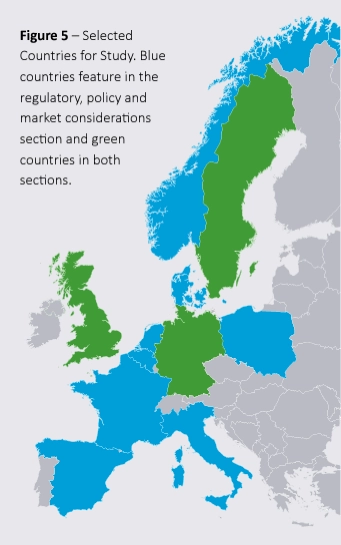While bidirectional charging (V2X) is advancing in Europe, this growth unfolds differently depending on the context of each country and its national policies.
A study titled “Assessment of the regulatory framework of bidirectional EV charging in Europe” reveals the current situation in European countries and which ones are laying the best foundations for assured growth.
This analysis was conducted by DNV, an independent provider of assurance and risk management, and SmartEn, a European business association integrating consumer-driven solutions for the transition to clean energy.
The analysis highlights that the countries with the highest likelihood of developing this technology are Norway, Sweden, Denmark, the Netherlands, Germany, and the United Kingdom.
Why do these countries stand out?
One of the variables taken into account is the penetration of electric vehicles and the deployment of charging infrastructure in each nation.
In this regard, the Scandinavian countries stand out.
Norway has a significant advantage, with 88 per cent of new car sales being electric, and it boasts 12.8 charging points per 1,000 EVs in its territory.

Sweden also holds a privileged position, with 59 per cent of zero-emission vehicles within its national sales. Additionally, it has 5.6 points per 1,000 cars.
Denmark follows, albeit with a smaller share of electric cars sold, at 38 per cent, which is still a high figure for Europe. It counts 5.8 points for every 1,000 vehicles.
Meanwhile, the Netherlands is the country with the most widespread charging infrastructure and, therefore, one of the best positioned to advance in bidirectional charging.
The country boasts 13.9 charging points per 1,000 EVs in its region, and electric vehicles represent 36 per cent of total sales.
Another crucial factor to consider for predicting the growth possibilities for this type of charging is the established regulatory policies.
Read more: How will European countries promote electric mobility in 2024?
These measures reflect the context in which the V2X sector will develop, set objectives that send signals to the market, and provide incentives that can support the business case for this technology.
However, clear policies do not guarantee that market conditions are ideal, as they must be accompanied by other regulations and measures.
In this regard, two countries stand out in the European context.
One of them is Germany, as its new charging infrastructure plan specifically refers to bidirectional charging, establishing the ambition for the electrical system to leverage the flexibility offered by electric vehicles.
Moreover, the German government provides specific support for research and development in V2X matters, as highlighted in the financial priority named “Bidirectional Fleet Power Plant 2025.”
The goal of this measure is to move beyond the pilot phase of bidirectional charging and enable broader distribution.
In this regard, additional bonus payments for combined photovoltaic solar energy and storage systems were recently introduced to promote overall expansion.
This approach encourages bidirectional charging in residential systems to optimize self-consumption.
On the other hand, the United Kingdom introduced legislation for smart charging in 2021, designed to ensure that charging points have smart functionality to reduce their impact on the grid.
However, this document did not have specific mentions of bidirectional charging.
It’s worth mentioning that in the rest of the countries, there is also a lack of laws mentioning the technology.
Nevertheless, in the vast majority of nations, there have been trials, and currently, there are pilot projects.
What’s the importance of V2X?
This technology allows the energy flow to shift from the grid to the car for recharging and vice versa, from the car to the grid for replenishing it.
Through bidirectional smart charging, if an electric vehicle is plugged into a public or private charging station, the battery can be charged or discharged.
In this way, it contributes to balancing the supply and demand of energy in the connected electrical grid.
In this regard, the advantages it provides are environmentally beneficial as it promotes less energy consumption, while also reducing economic costs.







